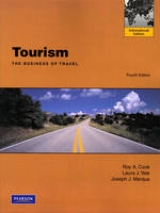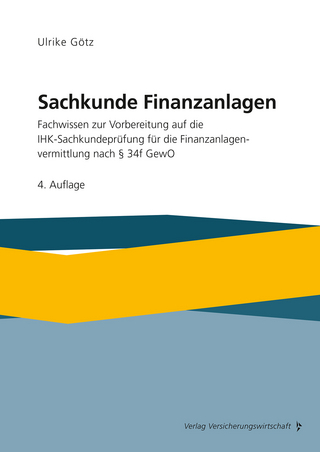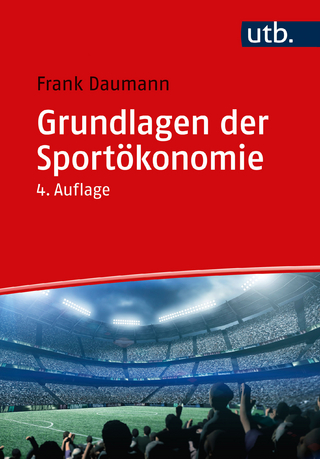
Tourism
Prentice Hall (Verlag)
978-0-13-219139-5 (ISBN)
- Titel erscheint in neuer Auflage
- Artikel merken
This third edition provides a through overview of the tourism industry and highlights the revolutionary impacts of technological changes on every segment of this industry. This book provides an accurate overview of today's tourism industry that's as interesting and multi-faceted as the field itself. Written in a conversational style that's fun to read, it takes a balanced, business-oriented look at each component of the industry—including the role of the travel agent and the importance of transportation modes, accommodations, destinations, attractions and food and beverage operations.
Roy A. Cook, D.B.A. (Mississippi State University), is Associate Dean of the School of Business Administration and Professor of Management, Fort Lewis College, Durango, Colorado. He has written a best selling textbook, Tourism: The Business of Travel, now being revised for its third edition, and two other textbooks: Human Resource Management, Meeting 21st Century Challenges and Guide to Business Etiquette. He has authored numerous articles, cases, and papers based on his extensive experience in the hospitality industry and research interests in the areas of tourism, strategy, small business management, human resource management, and communications. Dr. Cook is the Director of Colorado's Center for Tourism Research®, past editor ofAnnual Advances in Business Cases, and also serves on the editorial boards of Annual Advances in Business Cases, the Business Case Journal, the Journal of Business Strategies, the Journal of Teaching in Travel and Tourism, and theUNLV Gaming Research & Review Journal. He is a member of the Academy of Management, Society for Case Research (past president), and International Society of Travel and Tourism Educators. Dr. Cook teaches courses and consults in Strategic Management, Small Business Management, Tourism and Resort Management, and Human Resource Management. Laura J. (Richardson) Yale, Ph.D., holds B.S. and M.S. degrees in Hotel, Restaurant, and Travel Administration from the University of Massachusetts at Amherst. Subsequent to experience in the restaurant, institutional food service, and entertainment industries, Dr. Yale began teaching at Northern Arizona University. While in Arizona, she was instrumental in developing and directing a regional tourism association and served on the Governor’s Intrastate Tourism Committee. She received her Ph.D. in Marketing from the University of California—Irvine. Dr. Yale is retired from Fort Lewis College, after years of teaching courses and conducting research in Tourism and Resort Management and Services Marketing and Management. She now devotes herself full-time to writing and traveling. Joseph “Jay” Marqua has degrees from the Culinary Institute of America and Fort Lewis College. He is a hospitality and services executive with 20 years experience in operations, finance, and organizational design and development of food and beverage, lodging, resort, and gaming entertainment properties. He currently serves as the managing partner for The Tourism and Hospitality Development Group. The client list for his company has included organizations such as Amtrak, Aramark, the Culinary Institute of America, GWC Gaming, The Sky Ute Lodge and Casino, and SunRay Park and Casino. Mr. Marqua remains an active consultant, speaker, and trainer for hospitality organizations.
(NOTE: Each chapter includes Summary. You Decide. Net Tour. Discussion Questions. Applying the Concepts. Glossary. References.)
PART I.
1. Introducing the World’s Largest Industry, Tourism.
Could a Career in Tourism Be in Your Future?
Introduction.
Services and Tourism.
What Is Tourism?
A Tourism Model.
The History of Travel and Tourism.
The Empire Era.
The Middle Ages and the Renaissance Era.
The Grand Tour Era.
The Mobility Era.
The Modern Era.
Bringing Tourism into Focus.
Geography Provides a Window to the World.
Physical Geography.
Human Geography.
Regional Geography.
Studying Tourism from Business Perspectives.
Marketing.
Management.
Finance.
Tourism’s Challenges and Opportunities.
Where Do You Fit In?
Topics Covered in Each Chapter.
Readings: ASTA Ethics.
Even Tested Travelers Can Be “Provincial.”
2. Marketing to the Traveling Public.
A Ride on the Wild Side!
Introduction.
Decisions, Decisions, Decisions.
Information Seeking.
It’s All in the Details.
Foundations for Understanding Tourist Motivations.
Push and Pull Motivations.
Maslow’s Hierarchy of Needs.
The Leisure Ladder Model.
The Psychocentric–Allocentric Model.
Segmenting the Tourism Market.
Geographic Segmentation.
Demographic Segmentation.
Psychographic Segmentation.
Product-Related Segmentation.
Putting Segmentation Knowledge to Work.
Specialized Tourist Segments.
Business and Professional Travelers.
Incentive Travelers.
Mature Travelers.
Special Interest Travelers.
Delivering High-Quality Service.
Readings: Motorcoach Tours.
The Brand Boom.
3. Delivering Quality Tourism Services.
All’s Well That Ends Well?
Introduction.
Tourism Services.
Quality.
Defining Quality.
Quality Differences.
Service Encounters.
Service Quality Model.
Quality and Customer Satisfaction.
We Experience What We Believe We Will Experience.
Human Resources: The Key to High-Quality Service.
Understanding and Meeting Guest Needs.
Building Service Teams.
Service Mistakes.
Mistakes Happen.
Be a Can-Do Problem-Solver.
Service Guarantees.
Readings: Driving to the Bahamas: A Lesson in Guest Service.
Supply Chain Policies help Hoteliers Save Time, Money.
4. Bringing Travelers and Tourism Service Suppliers Together.
One Stop Does It All!
Introduction.
Serving Traveler Needs.
Why Use Intermediaries?
One-Level (Direct) Distribution Channels.
Two-Level Distribution Channels.
Travel Agencies.
Improving Service Delivery through Cooperative Systems.
Three-Level Distribution Channels.
Tours.
Tour Operators.
Consolidators and Travel Clubs.
Meeting Planners.
Tapping the Power of Dual Distribution.
Tourism Information Sources and Services.
Selling Adds a Personal Touch.
Acquiring Product Knowledge.
Approaching the Client.
Qualifying the Client.
Making the Sales Presentation.
Closing the Sale.
Following Up.
Building Relationships.
Readings: When Meeting Planners Go the Extra Mile.
21st Century Travel: Looking Ahead, Agents Expect to Be. Viable in the New Century.
Integrative Cases:Elite House: Using e-Service Recovery to Deal with Brick and Mortar Failure.
100% Satisfaction Guaranteed.
PART II.
5. Transportation.
The Graduation Gift.
Introduction.
Surface Transportation.
Plying the Waves.
Riding the Rails.
Amtrak and VIA Rail Canada Services.
International Passenger Rail Service.
Cruising the Highways and Byways.
Automobiles.
Motorcoaches.
Important Transportation Links.
Soaring through the Skies.
Operating in a Deregulated Environment.
Decoding the Language of the Airline World.
Improving Operating Efficiency and Effectiveness.
Internet Changes Travel Distribution Channels.
Readings: Both pricey, both in trouble, but air travel is no match for a train with a view.
The hub–and-spoke system remodels the airways.
6. Accommodations.
Expect the Unexpected.
Introduction.
Oh So Many Choices!
No Two are Exactly Alike.
Same Time, Same Place?
Your Attention, Please!
Enjoying the Great Outdoors.
Rooms, Rooms, and More.
Making Sense of Classifications and Rating Systems.
Lodging Lexicon.
Organizing for Successful Operations.
Going It Alone.
Franchising.
Management Contracts.
Chain Operations.
Strength in Numbers.
It All Begins with Sales.
Providing a Home away from Home.
Meeting Guests’ Needs.
Achieving Profitable Operations.
Using Technology to Tie it all Together.
Readings: Pillow Talk.
The New Opportunity for Independent Hotels.
7. Food and Beverage.
Sometimes It’s More Difficult Than It Seems.
Introduction.
Major Influences on the Development of Food and Beverage Services.
Travel and Discovery.
Science and Technology.
Building a Culinary Heritage.
The Beginnings of Modern Food-Service Practices.
Planning to Meet Guest Expectations.
It All Comes Down to Rhythm, Timing, and Flow.
Adding Value to Food and Beverage Experiences.
From Ten to Ten Thousand.
Building Profitable Operations.
Balancing Payroll Costs with Productivity.
Food Quality and Food Costs Are the Results of Effective Purchasing.
Using Technology to Improve Service Delivery.
An Ounce of Prevention Is Worth a Pound of Cure.
Beverages.
Beverage Operations.
Keeping Spirits Under Control.
Reading: Inviting the Media to Dinner: How, when, and why to stage a media dinner/event.
Operators find it’s no holiday attracting hard-to-get tourists.
8. Attractions and Entertainment.
So Many Things to Do and So Little Time.
Introduction.
A World of Opportunities.
Foundations for Understanding Attractions and Entertainment.
Heritage Attractions.
Museums and Historical Sites.
Zoos and Aquariums.
Parks and Preserves.
Fairs and Festivals.
Commercial Attractions.
Amusement Parks.
Theme Parks.
Gaming.
Emerging Gaming Segments.
Place Your Bets.
Shopping.
Live Entertainment.
Sporting Activities.
The Performing Arts.
Readings: The Future is Wow.
Is Legalized Gambling a $600 Billion Industry or a $50 Billion Industry?”
9. Destinations.
Dreams Can Come True.
Introduction.
From Resorts to Urban Destinations.
Classifying Destinations.
Far from the Maddening Crowd.
Links to the Past.
Seasonal Delights.
Spotlight on Sporting Activities.
Snow Holiday Resorts.
Golf Resorts.
Year-Round Playgrounds.
Spas.
Cruise Ships.
Casino Resorts.
Integrated Resorts.
Bright Lights and City Sights.
Building on Success.
Readings: Finding the best ship at the best price.
Great place to stay (employed).
Integrative Cases: Buying a Piece of Paradise.
Plotting a Course in Uncharted Waters.
PART III.
10. Economic and Political Impacts of Tourism.
Chamber Director Headache #1456.
Introduction.
Looking to Tourism for Economic Growth and Vitality.
Comparative Advantage.
Tourism and Foreign Exchange Rates.
The Multiplier Concept.
Realizing Tourism’s Export Potential.
What Goes Around Comes Around.
Tracking the Impact of Tourism Expenditures.
Other Economic Impacts.
Potential Problems in Tourism-Based Economies.
Tourism in the Economic Balance.
Tourism and Politics.
The Role of Government in Tourism.
Tourism Promotion Agencies.
Public/Private Organizations.
Chambers of Commerce and Convention and Visitors Bureaus.
Convention Centers.
Tourism Planning.
Political “Tugs of War” over Tourism.
Readings: The Four Seasons Challenge.
Coyote Pass Hospitality.
11. Environmental and Social/Cultural Impacts of Tourism.
Reflecting on the Future.
Introduction.
Tourism and the Environment.
Defining Carrying Capacity.
Determining Carrying Capacities.
Environmental Impacts of Tourism.
Social and Cultural Impacts of Tourism.
Host Community.
Social and Cultural Benefits of Tourism.
Using Culture to Attract Tourists.
Unintended Consequences of Tourism on Culture.
Mass Tourism versus Ecotourism.
When Is Tourism Too Much of a Good Thing?
Ecotourism.
Ways to Develop Ecotourism.
Ecotourism in the 21st Century.
Sustaining Tourism’s Benefits.
Readings: Preserving the Landscape of Cinque Terre.
Resorts Go Up . . . and Down.
12. The Future of Tourism.
On the Road Again.
Introduction.
The Shape of Coming Tourism Markets.
Demographic Shifts.
Disabled Travelers.
Changes in Business, Professional, and Conference Travel
Trends in Forms of Tourism.
Adventure and Extreme Tourism.
New Tourism Forms.
Meeting Future Tourists’ Needs.
Travel Agents’ Changing Roles.
Moving into an Era of Competitive Cooperation.
Accelerating Technological Advances.
Maximizing Operating Efficiencies.
Amplifying Guests’ Experiences.
Safety and Security Strides.
Transportation Transformations.
Internet’s Continuing Effects.
Keeping the Human Touch?
Conclusion.
Readings: Meeting the Needs of a Changing Industry.
Winter Snowsports Resorts: Destinations at a Crossroads.
Integrative Cases:Coping with Crisis.
West Marin: A Case-Study of Responsible Tourism.
| Erscheint lt. Verlag | 5.10.2005 |
|---|---|
| Verlagsort | Upper Saddle River |
| Sprache | englisch |
| Gewicht | 1572 g |
| Themenwelt | Wirtschaft |
| ISBN-10 | 0-13-219139-3 / 0132191393 |
| ISBN-13 | 978-0-13-219139-5 / 9780132191395 |
| Zustand | Neuware |
| Informationen gemäß Produktsicherheitsverordnung (GPSR) | |
| Haben Sie eine Frage zum Produkt? |
aus dem Bereich



